In an environment marked by economic uncertainty and shifting policy landscapes, the traditional approach of aggressive growth-focused investing appears increasingly risky. As forecasts indicate a slowing economy and a potential softening of stock markets over the next six months, investors must reevaluate their strategies. Relying solely on equities, especially in a climate of rising inflation and cooling employment figures, works against the need for stability and downside protection. The time is ripe for a paradigm shift—embracing fixed income and specialized ETFs that act as buffers could be the most prudent move, ensuring resilience while positioning for opportunities.
The Case for Fixed Income: A Counterbalance to Volatility
Veterans like Vanguard’s Roger Hallam advocate for a significant increase in fixed income allocations within portfolios. With the Federal Reserve expected to prioritize employment and possibly cut interest rates later this year, bonds could enjoy a renewed tailwind. Historically, bonds serve as a stabilizing force during turbulent markets, providing income and capital preservation. Hallam’s prediction that the bond market will benefit from the Fed’s potential dovish tilt underscores a crucial strategy: diversify into government securities and ETFs such as Vanguard’s new offerings centered on U.S. Treasurys.
The recent dip in the 10-year Treasury yield from around 4.57% to roughly 4.4% exemplifies the market’s sensitivity to shifting rates and economic outlooks. For long-term investors, holding a substantial stake in fixed income assets may offer not just safety but also an advantageous entry point to lock in yields that could become more attractive if the economy weakens further. This approach aligns with the broader notion that in uncertain times, conservative assets are a form of strategic insurance, allowing investors to remain flexible as conditions evolve.
Buffer ETFs: A Modern Hedge Against Market Downturns
BlackRock’s innovative buffer ETFs present an attractive alternative for those seeking downside mitigation without sacrificing all upside potential. These funds, such as the iShares Large Cap Max Buffer Jun ETF (MAXJ), adopt a “barbell” strategy—combining safety and growth—by offering capped gains while limiting losses. With a recent reset giving MAXJ a 7% upside cap, investors can participate in upward moves of the S&P 500 with reduced downside risk.
In an environment where volatility is a real concern, buffer ETFs act as strategic shields. Their appeal lies in offering a controlled exposure, enabling investors to avoid catastrophic losses during sharp downturns while still capturing some market returns. As the Federal Reserve’s monetary policy and global geopolitical developments create an unpredictable outlook, these products provide a tailored approach for risk-conscious investors determined to maintain a hedge against downside risks.
Positioning for a Future of Macroeconomic Shifts and Innovation
Beyond bonds and buffer funds, informed investors are increasingly turning their focus to macroeconomic themes that are shaping the future. Infrastructure development within the United States stands out as a geopolitical and economic priority, offering long-term growth prospects amid a fragmented global landscape. Incorporating these themes into a diversified portfolio can act as a form of strategic offense, especially when paired with cautious tactics like fixed income and hedging ETFs.
Furthermore, technological advances such as artificial intelligence continue to capture investor interest. While these themes are attractive, market participants should temper enthusiasm with a measured approach—recognizing that rapid shifts in policy, geopolitics, or economic data can alter the landscape overnight. A balanced strategy, emphasizing protective assets and thematic investments, ensures resilience even as dynamic macro trends unfold.
A Call for Honest Self-Assessment in Investing
Ultimately, successful investing in turbulent times demands a high degree of self-awareness and critical analysis. Recognizing one’s risk tolerance, understanding the limitations of growth-centric portfolios, and embracing strategic shifts are essential. It is easy to cling to past successes or to become overly optimistic about the market’s recovery, but realism and discipline are paramount.
Incorporating fixed income securities, buffer ETFs, and macroeconomic themes is more than a defensive posture—it’s an acknowledgment that markets are inherently unpredictable, and that adaptability is the key to long-term success. While these strategies might not promise rapid gains, they serve as a safeguard amid volatility, allowing investors to navigate the next chapter with confidence and prudence.

